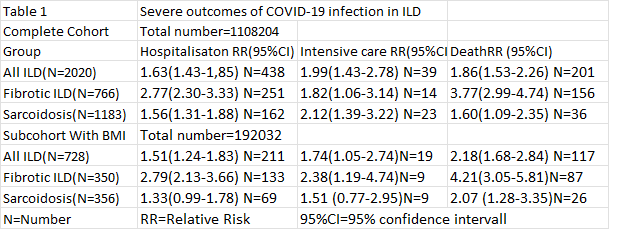Abstract
Background: Fibrotic interstitial lung disease (ILD) increases the risk of severe COVID-19 infection, with hospitalisation, intensive care and death. No clear evidence exists for other ILD including sarcoidosis.
Aims: To quantify the risk of COVID-19 for fibrotic ILD and investigate it in other ILD.
Methods: We used 2020-2021 data from the SCIFI-PEARL (Swedish COVID?19 Investigation for Future Insights?a Population Epidemiology Approach using Register Linkage) project, including pre-existing diagnoses, and severe COVID-19 outcomes (hospitalization, intensive care, and mortality) for all residents in Sweden ?18 years. Relative Risks (RR) were estimated using logistic regression for severe COVID-19 outcomes, adjusted for risk factors including sex, age, education, and underlying diseases. Sensitivity analyses were done in a subcohort where body mass index (BMI) data was available.
Results: ILD, and to a greater degree fibrotic ILD, showed significantly higher RRs (up to approx. 2 and to approx. 4, respectively) for severe disease in both analyses. For sarcoidosis, the results were significant in the total cohort, but not in the subcohort, except for death(Table 1).

Conclusion: ILD, especially fibrotic patterns, increased the risk for severe COVID-19 infection. For sarcoidosis, results were less clearcut, but an increased risk for death was shown.